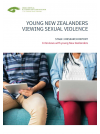Young New Zealanders Viewing Sexual Violence - Stage 1: This report is the first component of our research and consultation project exploring the effects of viewing sexual violence in mainstream commercial media such as movies, TV shows and games. Sexual violence is a complex social problem and its depiction and impact on audiences is not well understood, particularly with respect to young people.
Young New Zealanders Viewing Sexual Violence - Stage 2: This report is the second component of our research and consultation project exploring the effects on young people of viewing sexual violence in mainstream commercial media such as movies, TV shows, and games. We know from previous research that sex and violence in entertainment media can have a negative effect, however the impact of sexual violence specifically is not well understood – this is why we have made sexual violence our research focus for the past year. This phase of the research involved:
- 46 participants from 20 different organisations including NGOs, government officials, academics and others.
- Participants were grouped into four workshops, based around location and area of expertise, each approximately three hours long.
- Short video clips from films and television shows were shown to participants to prompt discussion
Young New Zealanders Viewing Sexual Violence - Stage 3: This phase of the research involved 24 paired interviews with 48 young people aged 13 to 18 from around New Zealand. Most were secondary school students and came from a cross-section of schools between deciles 1 and 10. We included a diverse group of young people including those who identified as survivors of sexual violence, LGBTQI youth, and young people from rural areas. Groups were divided by gender and age. Short, age-appropriate video clips from films and television shows were shown to participants to prompt discussion.
This phase of the research involved 24 paired interviews with 48 young people aged 13 to 18 from around New Zealand. Most were secondary school students and came from a cross-section of schools between deciles 1 and 10. We included a diverse group of young people including those who identified as survivors of sexual violence, LGBTQI youth, and young people from rural areas. Groups were divided by gender and age. Short, age-appropriate video clips from films and television shows were shown to participants to prompt discussion.
Methodology



